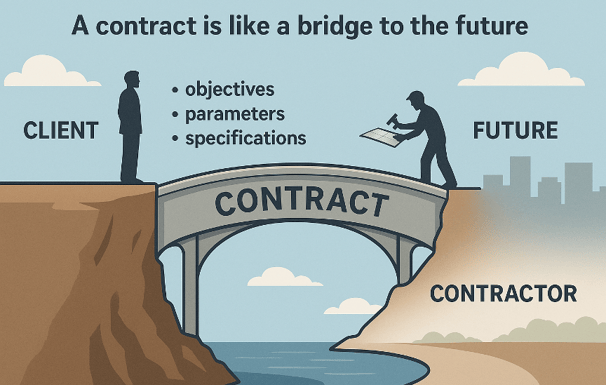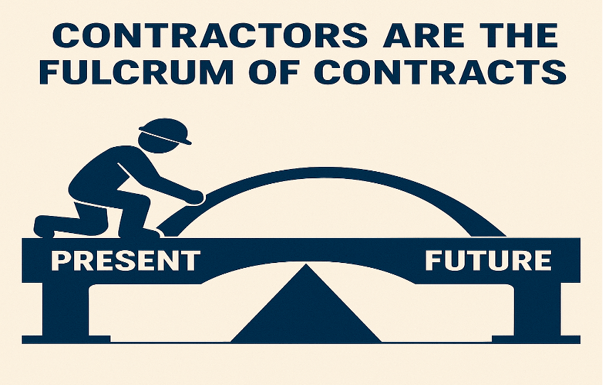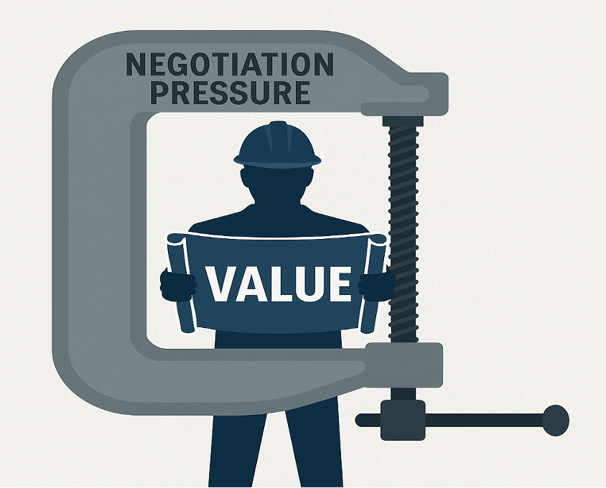
Why Contractors Are the Fulcrum of Contracts — And Why We Must Stop Squeezing Them?
Contracts
Dr Manoharan Murugeson
4/8/20253 min read


A New Way to See Contracts
What if we reimagined contracts not as rigid legal documents — but as bridges to the future?
The client defines the destination — setting parameters, expectations, and scope. The contractor builds the bridge, navigating terrain, risk, and constraints to make that vision a reality.
Without the contractor, the blueprint remains just that — a vision without momentum.
A contract, then, is more than terms and clauses. It is the structure that aligns intent with execution — and ensures that both client and contractor reach the other side together.
“A contract is like a bridge to the future.”
It begins with a vision — the client or buyer defines the destination by setting the objectives, parameters, specifications, and scope. They determine what the future should look like.
The contractor or supplier, in turn, becomes the engineer and builder of that future. Through their expertise, they construct the bridge — or pave the road — that leads from today's reality to the client’s envisioned outcome.
But without the contractor, that bridge remains merely a blueprint — a plan without execution. And without a clear, structured contract, the bridge risks being unstable, misaligned, or incomplete.
Thus, the contract is not just a document. It is the critical structure that aligns both parties, ensures accountability, and transforms vision into tangible results.
Why Contractors Are the Fulcrum of Contracts
Translators of Vision into Reality
While clients define what they want, contractors determine how to make it happen. They interpret abstract goals into executable tasks, making them indispensable to delivering value.Risk Bearers and Managers
Contractors absorb significant risk — cost overruns, delays, safety, compliance — and manage those on behalf of the client. Their ability to mitigate these risks determines contract success.Custodians of Time, Cost, and Quality
A contract may set the terms, but it's the contractor who balances the project triangle — ensuring deliverables are completed on time, within budget, and to the expected quality.


Innovation Drivers
Especially in EPC, tech, or complex service contracts, contractors often bring proprietary knowledge, innovative methods, and agile problem-solving that clients cannot provide.
Contract Success Depends on Their Performance
Even the most well-drafted contract is only as good as the contractor's capability and commitment. The contractor becomes the operational core of the contractual arrangement.


If Contractors Are So Vital, Why Are They Squeezed?
It’s a paradox in procurement.
We depend on contractors to deliver the future — yet too often, we treat them as adversaries at the negotiation table. We demand lowest cost, impose punitive clauses, and maintain a distrustful stance — as if the contractor is always trying to outsmart the system.
Why?
Past scars — Many clients have suffered from scope creep, bloated variation orders, and suspicious Extension of Time (EOT) claims.
Procurement metrics — KPIs often reward cost savings over long-term value or quality.
Contract as shield — Clients sometimes use contracts to transfer blame or create escape routes, rather than foster collaboration.
But let’s ask:
Is it wise to squeeze the very party that holds the tools to build your success?
Yes, there are contractors who abuse scope change processes. Some do bury hidden costs behind VO requests. Others game the system for EOTs.
But most of the time, scope creep results from incomplete briefs, moving targets, or lack of stakeholder alignment — issues that stem from the client side.
A Balanced Approach Is the Only Sustainable One
What we need is not blind trust — but smart governance, transparent tracking, and mutual accountability.
Great contracts are not about protection. They’re about partnership.
When clients and contractors co-own the outcome — with incentives, shared risk, and open dialogue — the project wins.
The Strategic Message
Whether you're a client issuing tenders or a contractor bidding for projects — remember this:
A contract is not a weapon. It’s a lever. And the contractor is the pivot point.
When both sides respect that role, we build stronger projects, healthier partnerships, and more resilient outcomes.




